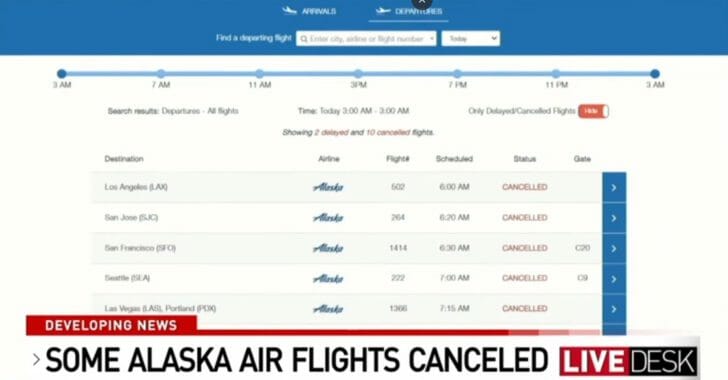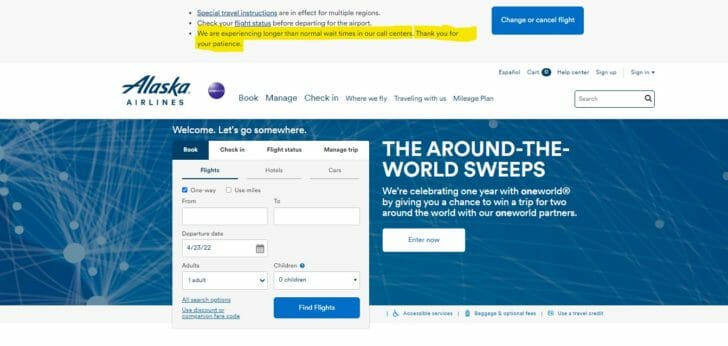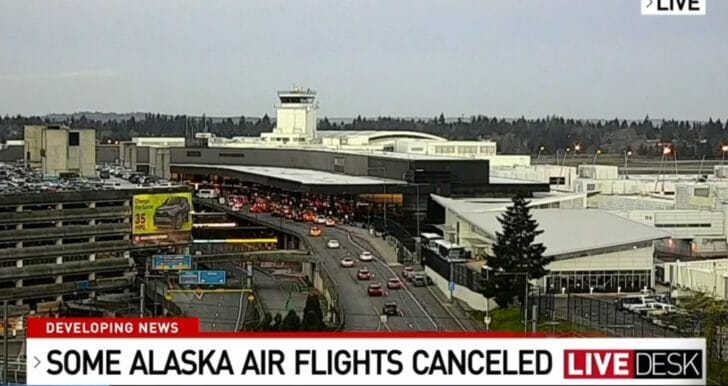Friday morning, Alaska Airlines cancelled 120 flights due to a pilot shortage as some pilots staged a walkout. Alaska Airlines pilots and their union, the Airline Pilots Association (ALPA) have been in contract talks with the airline.

Unfortunately, it left thousands of passengers stranded without any notice in advance. The Alaska Airlines website opening page wasn’t much help in explaining the situation by stating that passengers could experience delays in reaching a reservation agent. Passengers calling the reservation center were informed that the delay could be as long as ten hours.

A One-day Walkout
The pilots are represented by the Air Lines Pilot Association (ALPA) which has been in contract talks with Alaska Airlines for the past three years. Obviously, the Covid pandemic happening during contract negotiations was a major roadblock to negotiation talks. The walkout forced the airline to cancel:
- 66 flights from Seattle,
- 20 flights out of Portland,
- 10 flights from Los Angeles and
- 7 flights out of San Francisco.
Flights out of Anchorage were also affected.

The ALPA saws that Alaska Airlines did not adequately prepare for air travel to return following the pandemic which is affecting pilot recruitment and retention. Key issues with the pilots are:
- Job security,
- Work rules,
- Quality-of-life provisions and
- Flexible and reasonable schedules.
What Alaska Airlines Says:
In a statement released on Friday, Alaska Airlines said the following:
We understand how important it is to our pilots to secure a new contract. As the negotiations continue, we respect their right to engage in lawfully protected activities to voice their concerns.
We’re committed to reaching a collective bargaining agreement that recognizes the contributions of our pilots and supports them with increased pay, job security and greater work flexibility – key issues important to them.
It’s also vital for Alaska Airlines to negotiate a deal that allows us to maintain growth and profitability for a strong future. It’s crucial we continue to provide all of our employees with competitive pay and benefits as we hire more people, invest in new planes and fly our guests to new destinations. We believe the goals of the company and the goals of our pilots complement each other.
“A new pilot contract remains atop priority for Alaska,” said Jenny Wetzel, vice president of labor relations for Alaska Airlines. “We’ve put a package on the table that’s competitive and addresses the issues most important to our pilots. It’s a significant financial investment in our pilot group while recognizing that we are still working to recover from $2.3 billion in losses from the COVID-19 pandemic. We are eager to conclude negotiations quickly so our pilots can enjoy these new benefits as soon as possible.”
In support of our pilots, we recently presented the union with a comprehensive proposal. Among the highlights:
- We’re offering a top of scale wage of $280 per hour for captains and a market wage adjustment a year after the contract is ratified to keep our pilots’ wages competitive with their peers at other airlines. For reference, an Alaska captain’s average salary is currently $341,000 per year. For first officers, we’ve proposed a rate of $100 per hour, which would be the #1 new hire rate in the nation.
- We’re ready to increase the job security of our pilots: Any aircraft operated by Alaska Air Group over 76 seats will be flown by Alaska’s seniority list pilots.
- We’d add significant flexibility on how our pilots can set their schedules along with additional support for our reserve pilots. Our pilots currently work 16 days a month on average.
We’ve been in talks with the Air Line Pilots Association (ALPA) for a new agreement since the summer of 2019, with a mutual pause in talks for about a year as the industry weathered the pandemic. As a normal part of the process, we filed for mediation with the National Mediation Board in October 2021 to help move the process forward and facilitate an agreement. We look forward to making further progress at our next mediation session scheduled for later this month.
There are some flight cancellations connected to a shortage of pilots which has created operational challenges. We notified our guests whose flights have been impacted and apologize for the inconvenience. We’re working as quickly as possible to make things right and get them to their destinations.
The Pilot Shortage
There has been a pilot shortage for the past several years. Many career pilots are approaching the mandatory retirement age of 65. Even the U. S. Air Force is having trouble retaining career pilots. Training to be a private pilot could cost you around $10,000. Becoming a commercial airline pilot requires much more training such as:
- Instrument flight ratings,
- ATP – advanced turboprop ratings,
- Commercial pilot rating.
It’s not just the ratings requirements but also the minimum number of hours flown. This is where it really gets expensive. Renting an airplane the cost of fuel is very expensive. The cost of fuel at my airport in Salem, OR is $6.35 per gallon for avgas (self-serve 100 octane low lead) and $5.65 per gallon for jet fuel (Jet A). Many airlines are resorting to run their own pilot academies to meet the current and future needs of the airlines.
Alaska Airlines has launched the Ascend Pilot Academy in association with Hillsboro Aero Academy operating out of Bend and Portland, OR. The academy is assisting potential commercial pilots with:
- A $5000 stipend for completing an instrument rating certification,
- A $7500 stipend for completing a commercial pilot rating certification,
- Training to reach ATP minimum qualifications,
- Leading to a first officer position with Alaska’s regional airline, Horizon.

Final Thoughts
The rapid air travel recovery after Covid has left the airlines in a stretched position. The airlines lost an incredible amount of money over the past two years and they are struggling to get back to profitability. The pilot situation has been reaching a critical condition because there are recruitment and retention issues. Pilots are paid a lot of money because they are in a safety-sensitive position where making a mistake could have deadly consequences. If you are not training in the military, the cost of attaining the minimum commercial airline ratings could easily cost over $100,000. Alaska and other airlines are hoping to meet their future pilot needs by operating their own pilot academies.
